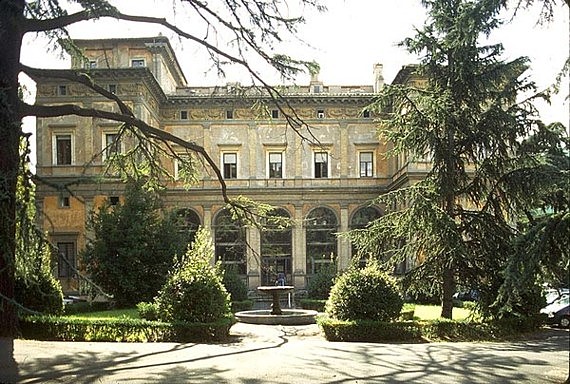|
|
 |
|
The Villa Farnesina |
|
written
by karadunn / 09.18.2004 |
|
|
| |
Introduction |
| |
| |

|
|
| The Villa Farnesina |
| View of the Villa Farnesina from the gardens (click on images to enlarge the pictures). |
| |
|
| |

|
|
| The Villa Farnesina |
| View of the Villa Farnesina from the main entrance. |
| |
|
"Key Figures: Patron and Artists of the Villa Farnesina"
The Villa Farnesina is a Roman villa built in 1509 for Agostino Chigi. At the time of its construction, the estate was located just outside of the city walls, and therefore considered a country villa. Today, it is only a short bus ride from the city center, located across the Tiber in the neighborhood of Trastevere. When considering the villa and its decoration, it is important to first consider the man it was built for. Chigi was a phenomenally wealthy banker from Siena. In fact, he was so incredibly wealthy and influential that he was honored with the title “Il Magnifico” by his hometown, was elected to be a senator, and was on intimate terms with Pope Leo X, who baptized Chigi’s illegitimate son (named Lorenzo Leone after the Pope) and eventually married Chigi to his mistress, Andreosia.
At this time, the Renaissance admiration for classical texts, art, and architecture had made the Roman villa fashionable again. In it’s classical ideal, it was meant to function as a retreat that could be devoted to quiet meditation and contemplation away from the city in the beautiful, rural countryside. Chigi, a business man first and foremost, had no desire to build a villa devoted to leisure hours and quiet reflection. Though Chigi did surround his villa with a large garden and fine stables, the building was meant to serve a business purpose as well. Being located so close to the city center, it was close enough for him to be able to return to the city in the evenings and his business there. The advantage of not being located too far away also allowed the villa to serve as a place where Chigi could lavishly entertain high prelates, noblemen, cardinals, and popes in a setting of wealth and grandeur. Comedies and poetry recitations were performed there for entertainment, and Chigi was famous for the extravagant banquets he held at the Farnesina. The most famous of these took place in his stables, when he tricked his guests into thinking it was his banquet hall by the lavish tapestries and decorations that were hung to conceal the stalls. At another famous banquet, he was said to have told the servants to cast the silver dishes each course was served upon into the Tiber after being used, to show his disdain for such trifles (though it is also said he placed a net below the surface of the water to retrieve the dishes with later). Whether or not they are true, the fact that these stories were circulated at all suggests the impressive scope and magnitude of his entertainments there. So, while the villa was built with classical architecture and function in mind, its true purpose was to impress upon guests the wealth, culture, and refined taste of the Chigi household.
Other key members involved in the construction of the Villa Farnesina include Baldassarre Peruzzi, an architect and painter, and Raphael Sanzi. Peruzzi was a famous architect who designed the Villa Farnesina and painted some of the frescoes as well. Like many great artists of his time, he was remarkable for the varied extent of his knowledge and skill. Not only was he a student of mathematics, a classical scholar, an architect, painter, and scientific engineer, but he also was a practitioner of minor arts such as stucco work in relief. The Villa Farnesina was one of the first works which brought renown to the young artist. On account of his success there he was appointed by Pope Leo X as architect to St. Peter’s, though his design for it’s completion was never carried out. Peruzzi continued to live and work in Rome and Siena until his death in 1536, when he was buried next to Raphael in the Pantheon. Raphael Sanzi, master painter of the Renaissance era, was commissioned to paint the "Triumph of Galatea", a beautiful fresco adorning what is now known as the "Hall of Galatea". Five years later, he was again commissioned by Chigi to decorate the ground floor loggia of the villa. A huge number of artistic works were completed or guided by Raphael during his regrettably short lifetime, and the Farnesina’s Galatea is considered to be one of his most accomplished pieces.
|
| |
|
| |
|
|
 |
|


